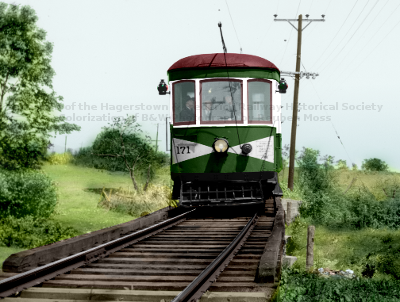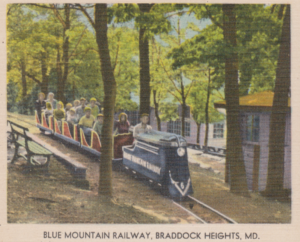What was to become the Hagerstown & Frederick Railway, a suburban (later interurban) trolley system, was formed by George William Smith and initially called the Frederick & Middletown Railway. Construction began early in 1896 with funding from Middletown businesses and farmers. This construction was almost simultaneous with the development of Braddock Heights Park, the mountaintop resort envisioned by Smith and other company executives that was intended to provide patronage for the line. Service between Frederick and Braddock Heights commenced on August 22, 1896.
The line was complete to Middletown by October of that year.
Two years later an extension was built to Myersville by the residents of that community, nominally called the Myersville & Catoctin Railway but leased to the F&M and operated as an integral part of the F&M. In 1904 the Hagerstown Railway built a connecting link from Boonsboro to Myersville, and through service between Frederick and Hagerstown became possible, making the still separate lines an interurban.
The Jefferson branch was added in 1906, running down the east side of Jefferson Boulevard. This extension served the H&F investors, who were largely the same as the Braddock Heights investors, by opening up more mountaintop resort land for development. An extension of this branch planned in 1907 which would have taken the line to the Baltimore and Ohio Railroad yard facilities in Brunswick was never completed.
Like the Frederick & Middletown, the Hagerstown Railway was begun in 1896. The leading investors were Christian W. Lynch and William Jennings. These men took a different approach to development by creating an urban loop within Hagerstown, with crossing lines on Washington Street and South Potomac Street, and a branch to nearby Williamsport. By 1897 line Potomac Street line extended to Funkstown.
In 1901 work began on an extension east to Wagner’s Crossroads (later Boonsboro Junction) and from there south to Boonsboro itself alongside what is today MD-66. This section was completed in 1902. Work began immediately on the connection from Wagner’s Crossroads to nearby Myersville.
In 1905 a new line was started, running north from Hagerstown to Shady Grove, Pennsylvania. This permitted a connection to the Chambersburg, Greencastle and Waynesboro Street Railway. Passengers could then take the CG&W on to the Western Maryland Railway’s Pen Mar Park and the mountaintop resorts of Blue Ridge Summit. Incompatible gauges prevented direct transfer.
 Emory Coblentz, a Middletown lawyer and stockholder in the Frederick & Middletown Railway, took over the management of the F&M in 1908. He bought the Washington, Frederick & Gettysburg Railroad which despite its name only ran from Frederick to Thurmont. Incorporating this line into the F&M in 1909 he renamed the company to the Frederick Railroad. During the next two years the network in Frederick was expanded and its facilities improved, with lines installed on Fifth Street, South Street and Market Street. In 1913, the Hagerstown Railway and the Frederick Railway were merged, becoming the Hagerstown & Frederick Railway.
Emory Coblentz, a Middletown lawyer and stockholder in the Frederick & Middletown Railway, took over the management of the F&M in 1908. He bought the Washington, Frederick & Gettysburg Railroad which despite its name only ran from Frederick to Thurmont. Incorporating this line into the F&M in 1909 he renamed the company to the Frederick Railroad. During the next two years the network in Frederick was expanded and its facilities improved, with lines installed on Fifth Street, South Street and Market Street. In 1913, the Hagerstown Railway and the Frederick Railway were merged, becoming the Hagerstown & Frederick Railway.
The company purchased and merged with several power and trolley companies over the following decade, including the Chambersburg, Greencastle & Waynesboro Street Railway just above the mason-dixon line. Over this decade the company began transitioning from a trolley company selling power to a company with a primary income selling electricity. In 1922 the company was renamed to The Potomac Public Service Company, and then at the end of the year The Potomac Edison Company. Under the P.E. name the company began investing in local bus services in addition to the long running trolley operations. In the 1930s several trolley routes were abandoned in favor of the parallel bus services. Despite the bus service Potomac Edison continued to operate passenger trolleys until the final line was closed on February 20, 1954. Freight continued with electric freight motors for another year. Diesels were operating the remaining freight services in Frederick when the company sold its remaining railroad assets in 1961.

Blue Mountain Railroad at Braddock Heights Park
In common with many more urban trolley systems, the H&F owned and operated two amusement parks, both as business ventures in their own right and as traffic generators for the trolley business.
In pre-air conditioning days, mountaintop parks like Braddock Heights Park were popular summer getaways where city dwellers could entertain themselves and breathe cool mountain air. Alongside the resort town founded by the railway’s officers, the park at the top of the mountain included tree shaded picnic grounds, miniature train and pony rides, an indoor carousel, ferris wheel, non-gambling “casino” with a skating rink, bowling and games, a playground that at one time included a retired trolley, a theater and a dance hall. Other entertainments came and went. The giant slide at the park is still fondly remembered by residents. A 3-story observation tower was the first structure built on the mountain in 1893 and offered a view of both the Frederick area and the Middletown Valley. Braddock Heights Park was sold to private owners in the 1950s and remained in operation until 1964. The skating rink remained in operation becoming the oldest operating rink in the USA until being destroyed by arson in 1998.
In 1920 the company purchased a park in Funkstown known over the years as Watts Park and Willow Grove Park. They renamed it Electric Park and operated it until 1925. Unlike Braddock Heights, this park had to rely on Antietam Creek for coolness, but served much the same functions as Braddock heights.
The Western Maryland Railway operated a similar park as well. Known as Penn-Mar Park the Hagerstown & Frederick advertised trips to this park in partnership with the WM and the Chambersburg, Greencastle & Waynesboro Street Railway (another trolley system later purchased by the H&F).
Delve deeper into the H&F with the following resources available from the H&FRHS!
Explore a few of our artifacts and photos with our Virtual Exhibit
See where the trolleys ran with our Interactive System Map
Take a look at the surviving trolleys and structures on our Survivors page
Check out a free digital back-issue of our Trolleywire Newsletter
Or take a look at a partial list of H&F trolleys and freight cars
Society members are given access to even more resources on this website including over 20 years worth of Trolleywire, artifact scans, timetables, a company employee listing and details about every Frederick and Washington County trolley we have information on. Learn how to become a member on our Membership page.
Have an Interesting Story About the H&F?
If you or a relative has a story related to the H&F, send it to us for inclusion on this site.
A Day on the H&F by Ira L. Swett – an account of a railfan trip in 1944 (click title to open) From the May 1946 Interurbans magazine, Alex Postpishil collection.


